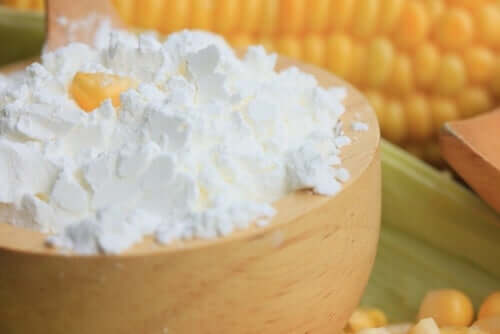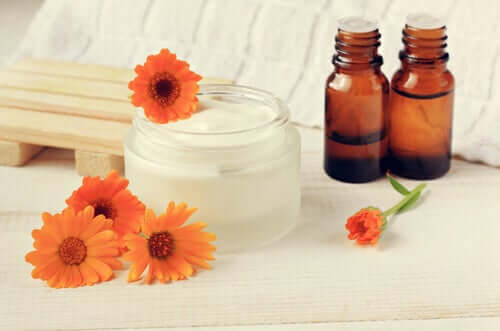Remedies for Heat Rash in Babies

Basically, heat rash (also known as miliaria) is a rash that’s characterized by inflammation of the skin, redness, and itching. Although it’s not contagious or considered a serious condition, it’s usually quite uncomfortable. Especially for babies.
The rash that appears on the dermis due to excess heat or humidity can occur as a result of excess clothing or fabric that doesn’t allow the skin to breathe properly. For this reason, it’s best to review the materials with which we dress our babies.
As in the case of remedies for mosquito bites, these shouldn’t be applied to the skin of babies without prior medical consultation. At the same time, keep in mind that the following remedies seek to alleviate the discomfort, but they can’t eradicate it.
When in doubt, it’s best to consult your pediatrician or a dermatologist.
Home remedies to relieve heat rash in babies
Cassava starch
Take 1 cassava and grate it until it’s powdered. In a bowl with mineral water, add the yucca and stir. When the powder dissolves into the water, strain the mixture. Discard the solid content and put the liquid in the sun for several days in a clean container.
Once the water evaporates, a whitish powder will remain at the bottom of the container. That is the starch of the yucca that you can apply to the baby’s skin as if it were talcum powder.
Baking soda water
If you want to relieve the itchiness and prevent the baby from constantly scratching the area where the heat rash is, we recommend that you give them a cool water bath with baking soda. This way, you’ll be able to relieve the itching and prevent the skin from being injured.
You should note that this remedy is much more effective if, once the bath is over, you dry your baby’s skin with a soft towel and without rubbing. At the same time, we recommend that you put cotton garments on it, as this fabric allows the skin to breathe.

Cucumber smoothie
Take 1 fresh cucumber, cut it into slices (without removing the rind) and place them in a blender. Add a little water and blend until disintegrated.
Refrigerate for a few minutes but don’t wait for it to get too cold. Once it’s ready, you can apply it to the rash.
Cucumber is a very fresh vegetable that will alleviate the condition. Remember that, once you apply it, you should allow it to act for a few minutes and then rinse gently. Repeat the procedure as many times as necessary.
Chamomile infusion
Chamomile is an herb with multiple beneficial and harmless benefits. Therefore, it can be used to relieve your baby’s heat rash.
To combat the effects of excess heat, you just have to prepare an infusion of chamomile. You can either use a bag of chamomile tea (the kind you find at the supermarket ) or soak and strain leaves of the plant (which can be found at health food stores). Once the infusion’s ready, place it in the refrigerator for 15 minutes.
Apply it with a cotton ball to the rash, dabbing it gently, without applying too much pressure. There’s no need to rinse when finished.
Aloe vera water
Take a stalk of aloe vera and cut it into small pieces. Place them in a container with boiled water and then put them in the refrigerator for 2 days. To apply it, you just have to use a little cotton.
Cornstarch
Cornstarch is another ingredient capable of relieving excess heat rash. You just have to take a little cornstarch and spread it carefully on the affected skin.

Calendula infusion
Like chamomile, calendula has multiple benefits and is a common ingredient in creams, lotions, and ointments to combat skin irritations.
If you have the leaves and stems of this plant on hand, we suggest you prepare an infusion with them, allow it to cool, and apply it to the rash (as a poultice) several times a day.

Another alternative for the rash
The remedy that we’ll suggest below can be prepared with over-the-counter drugs and, in principle, it shouldn’t contain any element that could be harmful to your child’s health.
However, you should first consult with your pediatrician before applying it. Remember that an allergic reaction to some component is always possible.
Drugs for treating heat rash:
- 1 azithromycin tablet
- 5 prednisone tablets (5 mg)
- 1 bottle of zinc and calamine lotion
Preparation method:
- Crush the tablets and add them to the zinc calamine lotion bottle.
- Shake the bottle so that the tablets dissolve well.
- Gently clean the area where the rash is located and apply the mixture with a little cotton.
- Wait a few moments for the skin to absorb the remedy and then dress your baby in a clean cotton garment.
- Be careful! You should never expose the baby to the sun as this remedy can stain the skin, which is why it’s best to apply it overnight and remove it in the morning before leaving home.
When is it necessary to consult a doctor?
The rash that occurs in babies due to excess heat, despite being very annoying, usually passes quickly. If you apply some of these natural remedies, your child will feel relief and the skin will regenerate soon.
However, if after a week, you see that it worsens or doesn’t improve, it’s time for a consultation with a doctor to determine the right course of treatment. You may need to apply another type of ointment. Even if it’s over-the-counter, it’s better if it’s prescribed by your pediatrician.
Seeing a doctor is also necessary if other symptoms like fever or sore throat appear while your child has the rash. Therefore, for the duration of the eruption, it’s best to take your child’s temperature at least once a day to make sure that everything’s going well.
Basically, heat rash (also known as miliaria) is a rash that’s characterized by inflammation of the skin, redness, and itching. Although it’s not contagious or considered a serious condition, it’s usually quite uncomfortable. Especially for babies.
The rash that appears on the dermis due to excess heat or humidity can occur as a result of excess clothing or fabric that doesn’t allow the skin to breathe properly. For this reason, it’s best to review the materials with which we dress our babies.
As in the case of remedies for mosquito bites, these shouldn’t be applied to the skin of babies without prior medical consultation. At the same time, keep in mind that the following remedies seek to alleviate the discomfort, but they can’t eradicate it.
When in doubt, it’s best to consult your pediatrician or a dermatologist.
Home remedies to relieve heat rash in babies
Cassava starch
Take 1 cassava and grate it until it’s powdered. In a bowl with mineral water, add the yucca and stir. When the powder dissolves into the water, strain the mixture. Discard the solid content and put the liquid in the sun for several days in a clean container.
Once the water evaporates, a whitish powder will remain at the bottom of the container. That is the starch of the yucca that you can apply to the baby’s skin as if it were talcum powder.
Baking soda water
If you want to relieve the itchiness and prevent the baby from constantly scratching the area where the heat rash is, we recommend that you give them a cool water bath with baking soda. This way, you’ll be able to relieve the itching and prevent the skin from being injured.
You should note that this remedy is much more effective if, once the bath is over, you dry your baby’s skin with a soft towel and without rubbing. At the same time, we recommend that you put cotton garments on it, as this fabric allows the skin to breathe.

Cucumber smoothie
Take 1 fresh cucumber, cut it into slices (without removing the rind) and place them in a blender. Add a little water and blend until disintegrated.
Refrigerate for a few minutes but don’t wait for it to get too cold. Once it’s ready, you can apply it to the rash.
Cucumber is a very fresh vegetable that will alleviate the condition. Remember that, once you apply it, you should allow it to act for a few minutes and then rinse gently. Repeat the procedure as many times as necessary.
Chamomile infusion
Chamomile is an herb with multiple beneficial and harmless benefits. Therefore, it can be used to relieve your baby’s heat rash.
To combat the effects of excess heat, you just have to prepare an infusion of chamomile. You can either use a bag of chamomile tea (the kind you find at the supermarket ) or soak and strain leaves of the plant (which can be found at health food stores). Once the infusion’s ready, place it in the refrigerator for 15 minutes.
Apply it with a cotton ball to the rash, dabbing it gently, without applying too much pressure. There’s no need to rinse when finished.
Aloe vera water
Take a stalk of aloe vera and cut it into small pieces. Place them in a container with boiled water and then put them in the refrigerator for 2 days. To apply it, you just have to use a little cotton.
Cornstarch
Cornstarch is another ingredient capable of relieving excess heat rash. You just have to take a little cornstarch and spread it carefully on the affected skin.

Calendula infusion
Like chamomile, calendula has multiple benefits and is a common ingredient in creams, lotions, and ointments to combat skin irritations.
If you have the leaves and stems of this plant on hand, we suggest you prepare an infusion with them, allow it to cool, and apply it to the rash (as a poultice) several times a day.

Another alternative for the rash
The remedy that we’ll suggest below can be prepared with over-the-counter drugs and, in principle, it shouldn’t contain any element that could be harmful to your child’s health.
However, you should first consult with your pediatrician before applying it. Remember that an allergic reaction to some component is always possible.
Drugs for treating heat rash:
- 1 azithromycin tablet
- 5 prednisone tablets (5 mg)
- 1 bottle of zinc and calamine lotion
Preparation method:
- Crush the tablets and add them to the zinc calamine lotion bottle.
- Shake the bottle so that the tablets dissolve well.
- Gently clean the area where the rash is located and apply the mixture with a little cotton.
- Wait a few moments for the skin to absorb the remedy and then dress your baby in a clean cotton garment.
- Be careful! You should never expose the baby to the sun as this remedy can stain the skin, which is why it’s best to apply it overnight and remove it in the morning before leaving home.
When is it necessary to consult a doctor?
The rash that occurs in babies due to excess heat, despite being very annoying, usually passes quickly. If you apply some of these natural remedies, your child will feel relief and the skin will regenerate soon.
However, if after a week, you see that it worsens or doesn’t improve, it’s time for a consultation with a doctor to determine the right course of treatment. You may need to apply another type of ointment. Even if it’s over-the-counter, it’s better if it’s prescribed by your pediatrician.
Seeing a doctor is also necessary if other symptoms like fever or sore throat appear while your child has the rash. Therefore, for the duration of the eruption, it’s best to take your child’s temperature at least once a day to make sure that everything’s going well.
All cited sources were thoroughly reviewed by our team to ensure their quality, reliability, currency, and validity. The bibliography of this article was considered reliable and of academic or scientific accuracy.
- Alonso Lazo, A. Y., & Álvarez Barrios, L. M. (2014). Uso de Hidrocortisona crema 1% en Niños (a) de 2 a 12 años con Dermatitis atópica atendidos en el área de consulta externa del Centro Nacional de Dermatología “Dr. Francisco Gómez Urcuyo”. Marzo–Agosto 2014 (Doctoral dissertation, Universidad Nacional Autónoma de Nicaragua, Managua). Disponible en: https://repositorio.unan.edu.ni/1647/
- Ureta, C. K. V., Cordero, A. W. H., Figueroa, E. E. J., & Tircio, D. C. N. (2021). Enfermedades dermatológicas, diagnóstico diferencial causas y tratamiento. Dominio de las Ciencias, 7(6), 1276-1294. Disponible en: https://dominiodelasciencias.com/ojs/index.php/es/article/view/2394/5266
- Weston, W. L., & Morelli, J. G. (2017). Dermatología pediátrica. Elsevier Health Sciences.
- Cardona R, et al. Más allá de la alergia a la yuca o mandioca. Revista Alergia México 2018;65(S1):63-64. Disponible en: https://revistaalergia.mx/ojs/index.php/ram/article/view/451.
- Nema NK, Maity N, Sarkar B, Mukherjee PK. Cucumis sativus fruit-potential antioxidant, anti-hyaluronidase, and anti-elastase agent. Arch Dermatol Res. 2011 May;303(4):247-52. doi: 10.1007/s00403-010-1103-y. Epub 2010 Dec 14. PMID: 21153830.
- Calderón-Oliver, et al. Efectos benéficos del Aloe en la salud. Vertientes 2011; 14(2):53-73. Disponible en: https://www.medigraphic.com/pdfs/vertientes/vre-2011/vre112a.pdf.
- Mishra A. Calendula officinalis: An important herb with valuable theraputic dimensions – An overview. Journal of Global Pharma Technology 2010;2(10). Disponible en: https://www.researchgate.net/publication/277731541_Calendula_officinalis_An_important_herb_with_valuable_theraputic_dimensions_-_An_overview.
This text is provided for informational purposes only and does not replace consultation with a professional. If in doubt, consult your specialist.








